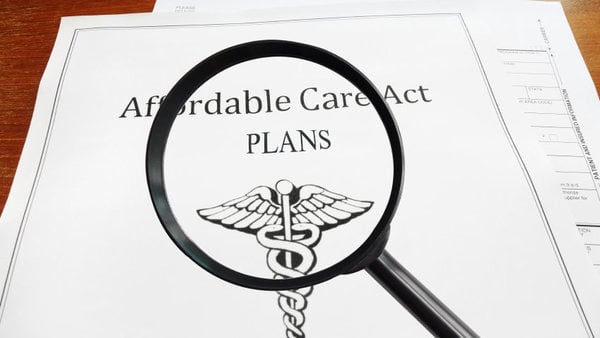 CMS isencouraging states to allow the sale of plans outside of exchangesthat don't incorporate a surcharge insurers started tacking on lastyear. (Photo: Getty)
CMS isencouraging states to allow the sale of plans outside of exchangesthat don't incorporate a surcharge insurers started tacking on lastyear. (Photo: Getty)
For those who make too much money to qualify for health insurance subsidies on the individualmarket, there may be no Goldilocks moment when shopping for a plan.No choice is just right.
|A policy with an affordable premium may come with a deductiblethat's too high. If the copayments for physician visits arereasonable, the plan may not include their preferred doctors.
|Related: Fewer taxpayers claim ACA subsidy, but those who doclaimed more
|These consumers need better options, and in early August federalofficials offered a strategy to help bring down costs for them.
|The guidance is from the Centers for Medicare & MedicaidServices, which oversees the insurance marketplaces set up by theAffordable Care Act. CMS is encouraging states to allow the sale ofplans outside of those exchanges that don't incorporate a surchargeinsurers started tacking on last year.
|Many insurers added the premium surcharges last fall to plans sold on the individual market. It was a response tothe Trump administration's announcement that it would no longer paythe companies for the “cost-sharing reduction” subsidies requiredunder the health law. The subsidies help cover deductibles andother out-of-pocket costs for lower-income consumers who buymarketplace plans.
|Insurers typically added the cost to silver-level plans becausethose are the type of plans that consumers have to buy in order toreceive the cost-sharing subsidies. “Silver loading,” as it'scalled, added an estimated 10 percent to the cost of those plans, according to theCongressional Budget Office.
|People who qualified for federal premium subsidies — those withincomes up to 400 percent of the federal poverty level (about$48,000 for one person or $100,000 for a family of four) — wereshielded from the surcharge because their subsidies increased tocover the cost.
|But people with higher incomes faced higher premiums. The newguidance is geared to help them.
|“It encourages states to encourage silver loading only on theexchange,” said Aviva Aron-Dine, vice president for health policyat the Center on Budget and Policy Priorities.
|But some analysts say they're unsure if the new federal policywill make a difference since states have already implementedsimilar strategies.
|Many states moved last fall to limit silver loading to planssold on the exchanges, while allowing or, in the case ofCalifornia, requiring, very similar plans to be sold off theexchanges without the extra premium charge.
|Yet CMS' endorsement of the strategy removes doubts states may have had, said David Anderson,a research associate at Duke University's Margolis Center forHealth Policy who has tracked the issue.
|Eighty-three percent of people who bought a plan during theopen-enrollment period for 2018 qualified for premium tax credits.The average monthly premium per subsidized enrollee was $639; afteraccounting for premium tax credits, however, enrollees owed just$89 on average. That amount was 16 percent lower than the monthly premium the year before.
|For people who don't qualify for premium tax credits, thepicture is very different. The average monthly premium for 2018 was$522. That total was 28 percent higher than the previous year'stotal of $407, according to an analysis by the Center on Budget andPolicy Priorities of CMS enrollment data.
|In general, federal rules require that insurers charge the same rates foridentical qualified health plans that are sold on and off theexchanges. The CMS guidance suggests that the unloaded plans couldbe tweaked slightly in terms of cost sharing or other variables sothat they are not identical to those on the marketplaces.
|Tracing what type of coverage is purchased off the exchange isdifficult because there is no centralized source. Consumers can buyplans directly from insurers, or they may use a broker or an onlineweb portal. According to one such portal, eHealth, 28 percent ofunsubsidized consumers on its site bought silver plans in 2018,while 42 percent bought bronze plans, whose coverage is lessgenerous than silver plans and typically have lower premiums.Conversely, on the exchanges nearly two-thirds of people bought silver plans in 2018 while29 percent bought bronze plans, according to federal data.
|If fewer insurers add the CSR load to silver plans sold off theexchange, those plans may be more affordable next year than theywere in 2018, said Cynthia Cox, director of health reform andprivate insurance at the Kaiser Family Foundation. (Kaiser HealthNews is an editorially independent program of the foundation.)
|“This makes silver plans an option for [unsubsidized] people whowanted to buy a silver plan but might have been pushed off onto abronze plan,” she said.
|Consumers who want to consider off-exchange plans have to findthem first. Some experts suggest checking with insurers that areselling on the marketplace in an area, because it's possible thatthey'll also be selling plans off the exchange.
|But that's not a given. A health insurance broker can helppeople find and evaluate plans sold off the exchange. But expertsurge consumers to stay on their toes and make sure they understandwhether the plans they're considering provide comprehensivecoverage.
|Starting in October, insurers can offer short-term plans withlimited benefits that last up to a year.
|“Differentiating between the two may not be easy, and theoff-exchange unsubsidized market is the target market forshort-term plans,” said Anderson.
|Please visit khn.org/columnists to sendcomments or ideas for future topics for the Insuring Your Healthcolumn.
|Kaiser HealthNews (KHN) is a national health policy news service. It is aneditorially independent program of the Henry J. Kaiser Family Foundation whichis not affiliated with Kaiser Permanente.
Complete your profile to continue reading and get FREE access to BenefitsPRO, part of your ALM digital membership.
Your access to unlimited BenefitsPRO content isn’t changing.
Once you are an ALM digital member, you’ll receive:
- Critical BenefitsPRO information including cutting edge post-reform success strategies, access to educational webcasts and videos, resources from industry leaders, and informative Newsletters.
- Exclusive discounts on ALM, BenefitsPRO magazine and BenefitsPRO.com events
- Access to other award-winning ALM websites including ThinkAdvisor.com and Law.com
Already have an account? Sign In
© 2024 ALM Global, LLC, All Rights Reserved. Request academic re-use from www.copyright.com. All other uses, submit a request to [email protected]. For more information visit Asset & Logo Licensing.








